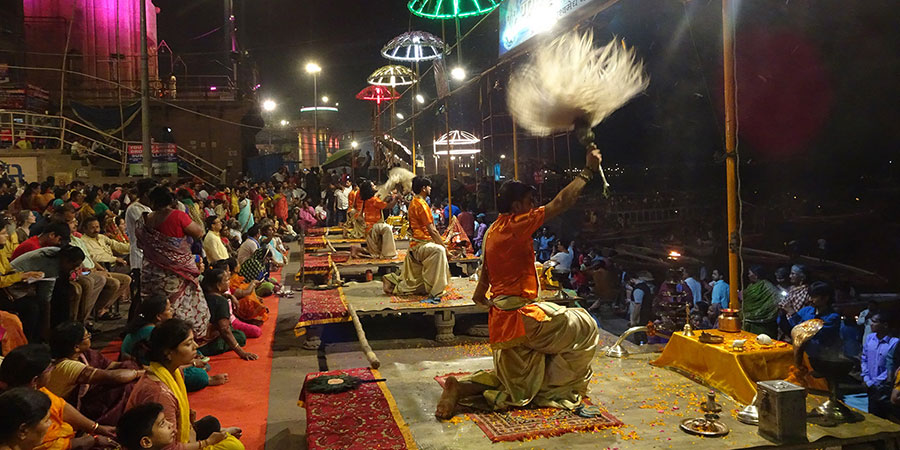Ganga Puja, Varanasi
Ganga Puja, also Ganga Aarti Ceremony, is a traditional ritual as well as the most representative event in Varanasi which brings mystery to India. Ganga Puja is regarded as a ritual ceremony to show the highest awe of Hindus for the mother river — Ganges River. As one of the most attractive highlights in Varanasi, Ganga Puja also includes wonderful and diverse activities: drinking sacred water, lightening lanterns and praying & blessing. Every night, Ganga Aarti Ceremony is held on time at Manikarnika Ghat and Dasaswawedh Ghat by the Ganges River, attracting numerous local residents and tourists coming and going. Usually the priests are selected from Brahmins — India’s highest caste. Young and handsome priests dressed in gorgeous silk clothes and the melodious music will lead audiences into the sacred atmosphere of worship. For a moment, it seems that all scenery and people go back thousands of years.

The Most Representative Event in Varanasi - Ganga Puja
|
Why is Ganga Puja held?
Ganga Puja, Ganga Aarti Ceremony, also known as KumbhaMela, has more than 1300 years history. Legend has it that in order to protect a pot which has magical effect of keeping immortality, all gods fought against demons. Later, the son of the great god Indra managed to steal the pot. Unfortunately, on the way back, he accidently spilled four drops of nectar, thus forming the four sacred places on the bank of Ganges River. From then on, Hindus hold the largest religious celebration among these four sacred places every 12 years in turn. During the entire 6-week pilgrimage, worshippers from all the country live in the most strenuous way. They live in tents or ashrams, eat the simplest vegetarian food and bathe every day, believing that bathing in the Ganges River during these auspicious days will cleanse them of their sins and put an end to the pain of life and death. With pilgrims and tourists coming every day, gradually, Ganga Puja is held every evening, rain or shine; while KumbhaMela still remains the greatest celebration with the highest scale.The Process of Ganga Puja
1. Before the ceremony, all instruments are wiped and wax pieces are prepared 2-3 hours in advance. As the last rays of the sun disappear in the western sky, the shore becomes ablaze with light. At dusk, pious believers walk towards the altar, holding incense, singing and waiting for the sacred ceremony which lasts for around 1 hour, rain or shine. With the beat of drums, leader singer and bandsmen are in place.2. Then the sacred bell at main ghat will ring, together with melodious song issued from the loudspeaker, indicating the beginning of this sacred ceremony. 14 handsome Brahmin priests, dressed in gold and red, highly hold the sacred fire and walk gracefully up to the altar. Led by the chief priest, all priests stand in a row facing the Ganges River, singing carols and applauding to the accompaniment of the music, as well as salute and sing songs to the statue of God Shiva.
|
|
3. Later, they enlighten incense, blow conch, enlighten a brazier-pot and wave feather fans in a series of enchanting poses. When sacred fire is lifted, all believers sing along and finally be immersed in a boundless atmosphere of holiness and solemnity. On the altar, priests chant and hold various sacrificial devices and the faithfully sit and listen. Filled with smoke, candlelight and lights, with religious music lingering and water of Ganges wandering, Ganga Puja brings a sense of peace and calm to everyone.
4. After the ceremony, people walk down the steps beside the altar to the Ganges, and pour the petals given by priests and milk into the water. Then put hands together and pray, and then sprinkle Ganges water over head or drink directly. Some buy small lanterns and put them into river after making a wish. They silently pray, and their eyes drift along the lanterns representing their wishes to the heaven in their hearts.
Tips
1. The Ganges is sacred for local people, but the water is not very clean, prepare yourself before having a bath.2. Don not swim in the Ganges, especially in the rainy season when the current is strong.
3. Photos and videos are strictly forbidden when watching cremation and Ganga Puja, and casual comments are not allowed during Ganga Puja.
4. Tourists are allowed to watch the ceremony at altar, and are recommended to enjoy a cruise trip.
How to get to Ganga Puja Site
1. After reaching Varanasi, passengers can walk from the old city to every ghat along the Ganges.2. Passengers can take rickshaws or electric cars; the price of the short distance is generally started from 20 rupees, and can be negotiated.
|
Entry fee |
Free |
|
Timing |
18:30-20:00 (depends on the time it gets dark locally) |
|
How much time to spend |
1-2hours |
You May Like:


